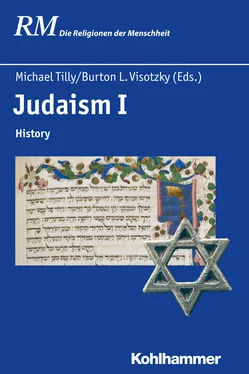Even as this monumental shift in the scholarly agenda was taking place, another significant change affected our understanding of Judaism. This transformation followed from the theological shift evinced by Vatican II and was apposite to the ending of what has been characterized as the Church’s millennial »teaching of contempt« for Judaism. 11European-Christian scholarship had, from the time of the separation of Church and synagogue, 12characterized Christianity as the direct inheritor of Greco-Roman Hellenism while Judaism, often derogated as Spätjudentum , was portrayed as primitive or even barbarian. In 1969, Martin Hengel (1926–2009) wrote a pathbreaking work of heterodox scholarship exploring the Hellenistic background of Judaism and how it was a seedbed for subsequent Christian Hellenism. 13
Hengel himself was relying in part on Jewish scholars such as Saul Lieberman, who wrote in the decades before him of Greek and Hellenism in Jewish Palestine. 14Lieberman, however, wrote particularly of influences on the literature of the ancient rabbis and targeted his work to scholars of Talmudic literature. Hengel, a German Protestant scholar, wrote for scholars of New Testament, and achieved a much broader reach and influence. Finally, one hundred fifty years after Zunz gathered his Berlin Verein , Hengel granted Jewish studies and Judaism itself a seat at the table of Christian faculties, even as he felt that Jewish theology of the ancient period erred in rejecting Jesus.
Since Hengel, there has been a vast expansion of Jewish Studies in universities in North America and throughout the world. Today, there is nary a university without Jewish Studies. In part this waxing of Judaica was due to the theological shifts in the Catholic Church and Protestant academy. In part, especially in the US, the explosion of Jewish studies departments was due to a general move towards identity studies that began with women’s studies and African-American studies, expanded to include Jewish studies, and other ethnic and religious departments, majors, or concentrations. In almost every university community in North America, fund-raisers were able to find willing partners in the local Jewish communities to endow a chair of Jewish learning. Thus, Jewish Studies persists even as many ethnic and religious studies programs wither with the general contraction of the humanities.
But Jewish Studies itself has changed in many profound ways. To wit, Christian scholars have also excelled in the field. At the time of this writing, the president of the Association for Jewish Studies, Prof. Christine Hayes of Yale University, is the first non-Jew to lead the organization in its 51–year history. Similarly, Peter Schäfer served as Perelman professor of Judaic Studies at Princeton University for fifteen years, having previously served as professor for Jewish Studies at the Freie Universität Berlin (1983–2008). Both Schäfer and Hayes specialize in Talmud scholarship. By this focus, we highlight not so much the anomaly of a gentile studying Talmud, as it is a sign of the integration of Jewish Studies into the broader academy. Indeed, as early as 1961, the late Rabbi Samuel Sandmel served as president of the otherwise overwhelmingly Christian membership of the Society for Biblical Literature. Today, the field has been leveled in both directions. Unfortunately, this apex has been reached just as Jewish studies, like the rest of the humanities, is contracting and diminishing not only in the United States, but even in Israel.
6 Kohlhammer’s Die Religionen der Menschheit
Since 1960, Kohlhammer in Stuttgart has published the prestigious series Die Religionen der Menschheit (The Religions of Humanity). While the series was originally conceived of as thirty-six volumes almost 60 years ago, today it extends to fifty plus volumes, covering virtually all aspects of world-religions. That said, a disproportionate number of the volumes (often made up of multi-book publications) are devoted to Christianity. This is unsurprising, given Kohlhammer’s location in a German-Lutheran orbit.
In the earliest round of publication, Kohlhammer brought out a one-volume Israelitische Religion (1963, second edition: 1982), which covered Old Testament religion. This also demonstrated Kohlhammer’s essentially Christian worldview. By separating Israelite religion from Judaism, it implies that Israelite religion might lead the way to Christianity; viz. that the Old Testament would be replaced by the New. Its author was Christian biblical theologian Helmer Ringgren.
In 1994, though, Kohlhammer began to address the appearance of bias with its publication of a one-volume (526 pp) work Das Judentum , Judaism. Although it was edited by German Christian scholar Günter Mayer, (who specialized in rabbinic literature), and had contributions by Hermann Greive, who was also a non-Jew; the work featured contributions by three notable rabbis: Jacob Petuchowski, Phillip Sigal, and especially Leo Trepp. German born, Rabbi Trepp was renown as the last surviving rabbi to lead a congregation in Germany. Trepp was arrested on Kristallnacht (Nov. 9, 1938) and sent to the Sachsenhausen concentration camp. Post-World War II, Rabbi Trepp was a leader in restoring Jewish life in Germany. 15Thus, his participation in the Judentum volume made clear Kohlhammer’s bona fides in publishing the volume.
In its current iteration, twenty-five years later, this edition of Judaism is a three-volume, 1000-page compendium with contributions by thirty experts in all areas of Judaism, from the destruction of the Second Temple and the advent of rabbinic Judaism, until today. We, the co-editors, are Dr. Burton L. Visotzky, Ph.D., a rabbi who serves as the Appleman Professor of Midrash and Interreligious Studies at New York’s Jewish Theological Seminary. The other co-editor is Dr. Michael Tilly, a Protestant minister, Professor of New Testament and head of the Institute of Ancient Judaism and Hellenistic Religions at Eberhard Karls University in Tübingen.
Further, the individual chapter authors are a mix, albeit uneven, of men and women (our initial invitations were to the same number of women as men, but as will be apparent, the final number favors men over women). And there are more Jews than Christians writing for these three volumes, although we confess to not actually knowing the religion of each individual participant. Scholars from seven countries make up the mix, with a preponderance of North-Americans; there are also many Germans, Israelis and then, scholars from England, France, Austria, and Poland. We are not entirely sure what this distribution means, except perhaps that the publisher and one of the editors is German, the other editor is American, and the largest number of Jewish studies scholars are located in America and Israel. The relative paucity of Europeans indicates the slow recovery from World War II, even as we celebrate the reinvigoration of Jewish Studies in Europe.
7 What is not featured in these volumes
Even given the diversity and number of exceptional scholars writing for this three-volume compendium—we will detail their contributions below—there are areas of Judaism that are less thoroughly covered than we might have wished, had we neither time nor word limits. An example would be a section on modern Jews of Color, who are gaining significance in both the U. S. and Israel. We recognize the rise in awareness and importance of non-white Jewish communities and look forward to there being a significant body of scholarship on their social and historical experiences as »a minority of a minority« in the years ahead, enough that it will become recognized as an academic specialization.
Читать дальше







